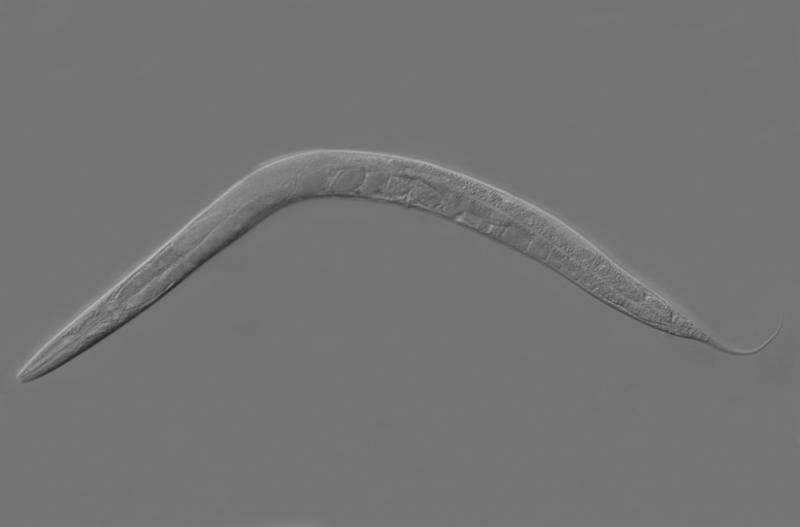Worm mothers provide milk for their young

As worm mothers age, they secrete a milk-like fluid through their vulva that is consumed by their offspring and supports their growth, according to a new study led by UCL researchers.
Scientists say the discovery, published in Nature Communications, shows both a selfless and sacrificial act, and helps to explain a number of mysteries about the biology of aging in the nematode worm Caenorhabditis elegans, widely studied to understand how organisms age.
Lead author Professor David Gems (UCL Institute of Healthy Aging) said: "We have now explained a unique self-destructive process seen in nematode worms.
"It is both a form of primitive lactation, which only a few other invertebrates have been shown to do, and a form of reproductive suicide, as worm mothers sacrifice themselves to support the next generation."
Most C. elegans, a one-millimeter long transparent roundworm, have both male and female reproductive organs, so the mothers reproduce by fertilizing themselves with limited stocks of self-sperm. When these run out, within days of sexual maturity, reproduction ceases.
The worms then behave in a way that has puzzled scientists for some time: they generate large quantities of yolk-rich fluid which accumulates in large pools inside their bodies, destructively consuming internal organs in the process. They also lay more than their own body weight in unfertilised eggs. Scientists previously assumed these changes were futile and represented some form of old-age disease state.
First author Dr. Carina Kern (UCL Institute of Healthy Aging) said: "Once we realized that the post-reproductive worms were making milk, a lot of things suddenly made sense. The worms are destroying themselves in the process of transferring nutrients to their offspring. And all those unfertilised eggs are full of milk, so they are acting like milk bottles to help with milk transport to feed baby worms."
The same lab previously showed that late-life yolk production is a self-destructive process. In long-lived mutant worms, that are specially bred and intensively studied to try to understand aging, self-destructive late-life yolk production and oocyte (unfertilised egg) laying is switched off. The new findings provide a potential explanation for how genes control C. elegans lifespan: by regulating this self-destructive process.
In the new study, the researchers found the milk-like fluid appears to benefit the young worms (larvae), as they found evidence that larvae were indeed ingesting the worm milk, and larvae that had access to a source of milk (which they also called 'yolk milk') grew more quickly.
Dr. Kern added: "The existence of worm milk reveals a new way that C. elegans maximize their evolutionary fitness: when they can't reproduce anymore because they have run out of sperm, they melt down their own tissues in order to transfer resources to their offspring."
The work could also have far-reaching implications in terms of the prospects of being able to slow the human aging process. Self-destructive and life-shortening reproductive effort of this sort is typical of organisms such as Pacific salmon that exhibit suicidal reproduction. This study suggests C. elegans lifespan may too be limited by suicidal reproduction.
Professor Gems said: "The amazing thing about aging in C. elegans is that lifespan can be massively increased by gene manipulation—up to 10-fold. This suggests that by understanding how this happens, one could find the key to slowing human aging, which is really exciting. But if C. elegans life extension is just due to suppression of suicidal reproduction like in salmon, then the possibility of applying our knowledge of worm aging to dramatically extend human life suddenly looks remote."
Yet the researchers say there is still more to learn about human aging from C. elegans. In an article accompanying the worm milk study, published in Frontiers in Cell and Developmental Biology, the authors present evidence that suicidal reproduction has evolved from more general mechanisms of aging, and that causes of aging-related disease are similar in both C. elegans and other animals such as humans.
Professor Gems said: "In the end, what is critically important is to understand the principles that govern the process of C. elegans aging and explain the causes of age-related disease more generally. We don't yet understand this for any organism. But for C. elegans we are getting there, and the discovery of worm milk gets us another step closer."
More information: C. elegans feed yolk to their young in a form of primitive lactation, Nature Communications (2021). DOI: 10.1038/s41467-021-25821-y , www.nature.com/articles/s41467-021-25821-y
Journal information: Nature Communications
Provided by University College London





















